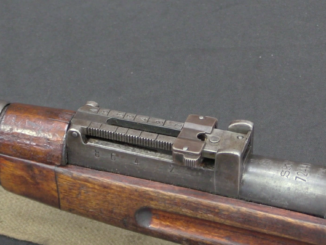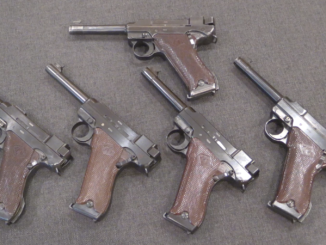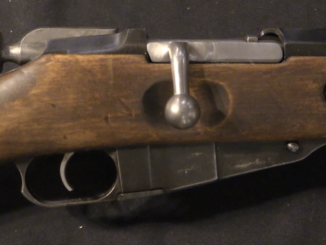In the wake of Finland gaining its independence, small arms were much in demand for the armed forces. Many rifles had been taken from Russian stockpiles in Finland, but not many handguns. Hugo Ahlberg ran Ab H. Ahlberg & Co Oy, a machining company in Turku and he decided that making guns for the government would be a great way to get some stable and profitable business. He made a copy of the FN Model 1910 pistol in .32 ACP, and proposed to the Army.
After a bit of tweaking (the barrel and slide were made 15mm longer than the original pattern), a deal was made for Finland to purchase 1,000 Ahlberg pistols. As so often happens in this sort of situation, production turned out to be much more difficult than Ahlberg had anticipated. He failed to meet delivery deadlines, and quality control problems made at least 20% of his production scrap (of 1,000 pistols delivers, serial numbers are known as high as 1,251). Ahlberg grew frustrated that he was taking a financial loss on the project, and the Army got frustrated that it wasn’t receiving its pistols.
Ultimately, the contract of 1,000 pistols was fulfilled by Ahlberg, although the promised additional orders were cancelled. Instead, the Army purchased a quantity of surplus Ruby pistols from France. These would turn out to be unsatisfactory, leading to later purchases of Luger pistols from Germany. Still, the Ahlbergs were used by the government in a variety of roles (included Defense Forces and police) into the 1960s before the last remaining ones were finally sold as surplus.




Making guns is always harder than it looks from the outside…
Yes we all know that three D printing will soon let us have 150mm field guns in our backyard We will even be able to print the shells and powder.
Most orders for a Star trek replicator will probably be for beer, @ 04:00hrs. Slovakia are good… Euro 2021.
Modified Wankel engine; gun, gas propellent: Nitrous oxide via adiabatic process… Dieseling, exhaust = rotary mag of 30mm mk108 rounds. Volksjäger…
Might work, spin, compress, compress, etc, then bang, bang, bang; shells in front of “banger” exhaust I.e. Barrel.
Starship troopers. Want to know more? Armament… In an experimental jet fighter.
In these “Rona” times, pilot uptake would be very high. We could ask them if they want to be a pilot in McDonalds.
Swarm. Cheaper than drones, they’ll definately see off a Mig 35, 200 of them.
At the cost of about 50k vs the Mig. Training, because nobody will be able to fight with modern planes for long; far to expensive, they are from an age of when war was unlikeky.
Times change.
Yes it will explode, in a bit; but unlike ww1 they will have a parachute.
Progress.
I would wager that even with a replicator, you’re gonna have design and production issues creep in.
Not only should we consider the fact that a weapon designed around a specific production technology/material may or may not adapt to another, there’s the issue of “How does this replicator actually work?”. Consider, for example, just how much grief you’d have trying to produce the Mauser 98 via stamping–You’d have to redesign the whole weapon by the time you were done, and you might as well just have started with a clean-sheet “stamped bolt action” instead of trying to adapt that which was designed for production on manually operated machine tools.
CNC does not equal out to manual machine tools, either–You have to have a different approach to production. What might be fine with artisanal craftsmanship, as in say a BREN receiver, or the Oerlikon 20mm… Might not be very adaptable to automated CNC production. At. All.
There’s a lot of knowledge packed into those old craftsman’s hands, and a modern CNC tool might not actually be as adaptable as that old-timey master machinist that could adapt on the fly. Someone mentioned a situation the other day in aviation, where a machinist retired, took his knowledge with him, and then the new kid couldn’t produce the parts needed.
I think you’d have to adapt the design–You could probably make a workable 40mm grenade launcher out of a 3D printer, but the design would have to be totally different from something you churned out of an aluminum forging on a CNC mill.
I’ve tried to figure out how the hell you’d get to something like a Star Trek replicator without using handwavium, and about the best thing I can come up with is that you’d have to have some kind of platen that brought the materials to its surface as it extruded the item you were “replicating”. As well, you’d have to sacrifice at least a copy of what you were trying to replicate, so the process would likely be “Lay unobtanium onto the platen, allow it to disassemble said object molecule by molecule so as to produce a file of what you needed it to do, and then waiting while it built you copies by reversing the process…”. So, if you have fantasies of getting the local museum to allow you to borrow their cool thing, my guess is that they’d have “issues” with you doing that. At best, they’d let you non-destructively scan it, and you’d have to pray to the machine gods that it went right. I would imagine that there’d still be problems stemming from that process.
What would be interesting about such manufacture is that you could probably get away with having hand-built prototypes with minimal documentation, just playing around with hand-fitting everything and not caring. Then, have it sucked into the platen, and Hey! Presto!, you’ve got all you need to create more at need.
Whatever comes, it’s gonna be different than what we know now, and I would wager that it will require a different way of doing things. A design in stamped steel is going to have to be designed and manufactured differently than one in forged aluminum, which will in turn be different than something churned out on a 3D printer in a plastic…
The ST replicator was created by Rick Berman, producer on Star Trek; The Next Generation.
The reason was that he wanted to take Gene Roddenberry’s original idea, which was a basically Fabian Socialist future, into a level where there was no reason for even having money. (In case you haven’t noticed, ST has been essentially an infomercial for “scientific” socialism since 1964.)
It says a lot about the essential failure of the concept that Berman had to resort to Clarke’s Law (“any sufficiently advanced technology is indistinguishable from magic”) to maker it even halfway believable.
Also, it requires energy. Who pays the “electric bill”, and with what?
In fact, the replicator is magic. But then so is the “transporter” it was supposedly based on.
As to how a real “matter transmitter” could (theoretically) work, read Tunnel In The Sky by Robert Heinlein. Or just watch a rerun of Stargate SG-1.
But neither one will ever beget a “replicator”.
cheers
eon
Oh, don’t get me started on the many and varied idiocies of the various science-fiction universes they’ve dreamed up. Roddenberry was especially bad, and the utter lack of internal self-consistency used to drive me nuts. Same with Lucas…
Here, I’m trying to project how such a thing might work in the real world. Molecular assembly and disassembly might work as I’m describing it, but there are a lot of hand-waves between where we are now and something like that actually working. The idea of a Star Trek-like matter transporter, which is really a scanner and remote assembly mechanism combined? I think that’s patently ridiculous, and was essentially an ass-pull that Roddenberry came up with in order to reduce costs for filming–No shuttles required, see? And, it created so many issues with the whole universe that it’s not even funny.
Heinlein did it better as some kind of wormhole tunnel between points, but I still wanna know how the hell you’d even begin to compensate for all the motion involved–I mean, for the love of Newton, the planet is moving, the solar system is moving, and the galaxy is moving, all at the same damn time… So, you project a wormhole, how the hell does it anchor on both ends?
To a degree, most of Star Trek and Star Wars are really more “space fantasy” than any sort of recognizable science fiction. I’m still in awe of the fact that either one has met with any success, and meanwhile, the really good SF and fantasy can’t get filmed or much of any public attention. Ah, well… I keep hoping someone will pick up almost anything of Vernor Vinge’s… It’d be nice to see some of his stuff on film. Pham Nguyen for the win… 🙂
Adults have nothing better to discuss than Star Trek replicators and meantime your country is quietly invaded, publicly rots You all are a disgrace to the values you claim to honor.
A bit surprising that the Ruby might be picked as an alternative. No replacement parts, no interchangeability, no guarantee that any given magazine will function unless its kept matched to the original gun.
‘Cheap’ goes a long way I guess.
‘Cheap’ DOES go a long way, especially when something of quality may simply be unavailable at the time it is needed most.
France purchased Spanish Ruby .32 pistols in quantity during WWI when they had nothing else, adopting them as a standard arm; Price wasn’t the concern, it was availability–NOW, instead of in a year or so. The Ruby pistols worked for the most part, they could be obtained in quantity, and that met the requirements. The important thing was to HAVE pistols; Everything else was secondary.
A cheap gun in the hand is many times better than a really nice one that hasn’t been built yet.
To be honest, a pistol is used mostly to hold prisoners and subordinates in line, and a ruby does that as well as any other pistol.
Depends on the war, and the army.
Not to mention, the position of the soldier issued the weapon–A machinegunner in Vietnam or a medic in Afghanistan have far different expectations and needs from their pistols than a staff officer on the General Staff during either World War.
It’s a little difficult to defend yourself from someone attacking you in a toilet stall of a latrine with a rifle, as someone on FOB Speicher had to do circa 2006. An ambitious infiltrating local decided to get a weapon “on the job”, and went after a guy who was otherwise engaged. He wound up wrestling the idiot and choking/beating him to death while his pants were around his ankles. Turns out, assaulting a guy who’s about twice your size while he’s sitting on a toilet is not a really good idea… The rifle he was going after never entered into the encounter, and was still hanging on the door when responding parties came on the scene.
There were reasons I wanted a pistol in Iraq, at all times. The rifle just doesn’t cut it, when you’re dealing with “sudden Jihad syndrome”.
In the case of the French Army in WW1, the Ruby pistols were needed for trench warfare, not guarding prisoners or hanging in a shiny leather holster on an officer’s Sam Browne belt.
When going on (or defending against) a trench raid, given the choice between an entrenching tool with a sharpened edge, a homemade wooden “trench club” with nails sticking out of it, and a .32 automatic or revolver, I’d rather have the pistol.
BTW, the “Ruby” firm also made copies of the S&W Military & Police (later aka Model 10) in 8 x 27mmR for the French Army at the same time. Because there just weren’t enough Mle 8/92 Ordnance revolvers to go around. The poilus called it the “92 espagnole” and it seemed to work well enough.
The rifle may be the primary infantry weapon, but in a real war, when someone needs a handgun, they generally need it RDN (Right Damned NOW).
cheers
eon
When your issue rifle going into the 2nd WW is a reworked Mosin, it means your country is poor. Immediately following the 1st WW, surplus French Rubys must’ve seemed a godsend to Finland.
Outwardly it looks a lot like an Ortgies.
Sexy name :-))
Google translate again probably; not orgies I.e. Group sex, incidentally I tried that in Germany “Such things go on, there.” To be honest I found looking at an overweight red faced German man, while… “at it” going oh ya… Detrimental to the entire process he he.
If you ever watched South Park; I hope you never did what Cartmans mom did in german porn movies, heh
Did ‘everyone / country’ make (or propose)a copy of FN1900-1910? Did FN make any significant efforts (successful or otherwise) to chase these?
Read Handguns of the World by E.C. Ezell. The chapter on the designs of John Moses Browning describes his long-standing relationship with FN-Liege, and the truly huge number of copies of his designs, notably the Model 1910 and the “Baby Browning” that were literally made all over the world. Plus FN’s ultimately futile legal efforts to stop the patent infringements.
cheers
eon
What was process which lead Finnish Army to decide that 7,65 mm Browning cartridge will become their automatic pistol cartridge?
Back in 1918 there was little process. 7.65 Browning (.32 ACP) was commonly used by many countries in WW1, France and Germany included, and while it wasn’t probably the best choice, it was a logical choice for a simple blowback pistol, which was probably the best Finnish industry could hope to manufacture at the time.
In the same vein were the Ruby pistols purchased from France — they were available and cheap, like many people have already correctly pointed out. The Rubies were not really worse than the Ahlberg pistols, because the latter did not have interchangeable parts either. In fact the better Rubies were probably of better manufacturing quality than the Ahlbergs.
I don’t think Finland really had a “pistol tradition”, either. In the US, it’s an easy step from the varied fantasies and myths of frontier life (along with the very real fact of the pistol as tool for the wilds here in the US…) to a pistol that’s fully capable of doing what we consider to be essential for a modern “combat pistol”.
Most Finnish cavalry tradition goes back to the Hakapelliita days, and did not include the dragoon modes of operation that fed into the American tradition of the firearm-carrying horse soldier. I’m not sure why that was, but I suspect it has a lot to do with the lack of emphasis on the pistol as a serious military arm, and the more general perception that it was more a badge of rank than anything else.
At least, this is the general impression I’ve gotten from reading and talking to Finns of my acquaintance. I think the perception of pistol utility has shifted down the years, but during the immediate aftermath of WWI, I don’t think the Finns really thought the pistol was either important, or any sort of serious weapon. Then, too… Having a good rifle was probably way more important for your typical woods-running Finn who was more prone to settling personal disputes with a puuko than anything else. I suspect that a pistol would have been seen as an effete thing for the cowardly among a lot of those folks–They certainly had that attitude amongst the Finnish immigrants where I grew up in Oregon. Rifles and knives everywhere, hardly any handguns.